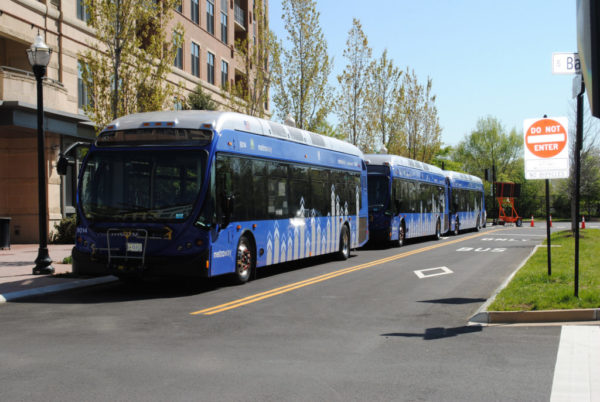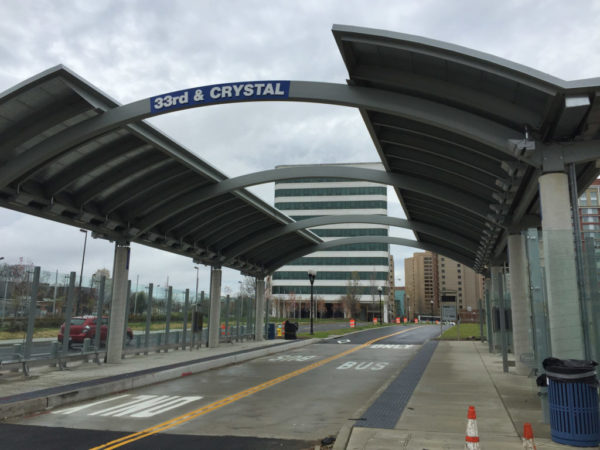
A decade ago, when Arlington County was in the midst of planning the Crystal City Potomac Yard Transitway for the future Metroway bus rapid transit line, the Route 1 corridor looked a lot different.
Development was still ongoing in the corridor, which encompasses Pentagon City and Crystal City, and Amazon was still years away from selecting the area for its HQ2.
There were just over 17,000 residents in the corridor and nearly three quarters of them lived in rental units, according to 2010 county census data. By 2020, that number had risen by about 15% to 20,000 residents. Renters now occupy 91% of the housing stock, according to county data.
Arlington’s section of the Crystal City Potomac Yard Transitway opened in 2016 with the Pentagon City extension aiming for a 2023 opening.

While there have been plenty of bumps along the road, including the continued delay of the Potomac Yard Metro station and low ridership during the pandemic, at least one transportation advocate praises the county for looking ahead.
“To do this later, after the development happens, would have been 20 times harder. 100 times harder,” Chris Slatt, Arlington Transportation Commission chair and founder of Sustainable Mobility for Arlington, told ARLnow. “I really give Arlington a lot of credit.”
In terms of Potomac Yard, Slatt made the point that this was an extremely rare opportunity where urban and transportation planners had the ability to start anew and could try out their best laid plans without dealing with already existing infrastructure.
“Potomac Yard was this kind of special opportunity that we don’t have very often,” said Slatt. “I’m sure there are a lot of other places in Northern Virginia where we can say we’re basically a new neighborhood from scratch.”
Local officials agree, which is why the Metroway is such an exciting project for them.
“For mass transit planners… it is a lot easier to design the infrastructure when you’re starting from scratch rather than trying to retrofit it into a pre-existing system, particularly if you want dedicated [transit] lanes,” said Eric Randall, principal transportation engineer with the Metropolitan Washington Council of Governments (MWCOG).
Plus, he noted, it’s easier for residents to get in the “frame of mind” to use the mass transit option if it is there initially, as opposed to needing to break their previous habits.
While HQ2 wasn’t a factor until 2018, it was anticipated that this corridor was in line for major redevelopment.
“As it turned out, Amazon HQ2 moved in there, but it could have easily been some other major tenant,” said Randall. “Arlington County did the planning and that’s what made them attractive to Amazon.”
There is also the Virginia Tech Innovation Campus, which broke ground in September and is expected to open a number of buildings by 2024.
Despite all of this work on mass transit infrastructure both in the country and in the region, there’s still concern that it may not be enough.
Stacy Cook, a principal transportation planner with MWCOG, told ARLnow even after significant investment in mass transit infrastructure, we should still expect a significant increase in congestion and traffic delays in the coming years.
“We [need] aspirational initiatives, big ideas,” Cook said “One of those is expanding [rapid bus transit] and transitways.”
That’s why the Pentagon City expansion was an important step, she said.
Additionally, the hope is that the Transitway infrastructure won’t just be used for Metroway buses, but the 16M Metro bus line down Columbia Pike as well, Arlington’s Transit Bureau Chief Lynn Rivers confirmed to ARLnow, when that potentially comes online in 2023.
But all of this comes back to residents and commuters. Even if the infrastructure is there and the mass transit is running as it should, it’s on residents and workers to utilize and actually take it.
Lower-than-expected ridership numbers even in 2019 are somewhat concerning, but officials continue to insist that was due to Potomac Yard still in the midst of redevelopment.
Slatt said now is the time — with new infrastructure, mass redevelopment, and the pandemic potentially changing commuter habits — for people to form lasting transportation habits.
“Smart transit agencies are going to see this as an opportunity. This is a time of change. How can we help people make the right choice?,” he said. “What can we do to influence people’s changing transportation behavior and to get them on to transit?”
This is the third of a four article series on the bus rapid transit system in Crystal City.
Previous:

